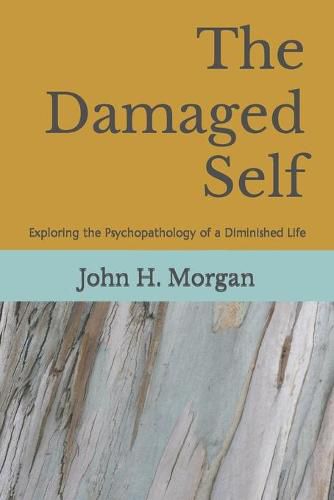Readings Newsletter
Become a Readings Member to make your shopping experience even easier.
Sign in or sign up for free!
You’re not far away from qualifying for FREE standard shipping within Australia
You’ve qualified for FREE standard shipping within Australia
The cart is loading…






The psychopathology of a diminished life producing a mental injury is characterized by the downward spiral in an individual’s self-concept (self-image and self-esteem) brought on by a diminished opinion of one’s self resulting from negative interpersonal experiences especially from childhood. This approach is based on the work of Harry Stack Sullivan, M.D., and is explored within the context of the traditional orientation of psychoanalysis developed by Sigmund Freud, M.D. A damaged self is evidenced in a variety of personality disorders described in the DSM-5 and is treatable using a variety of psychotherapeutic modalities of intervention which will be explored here. The reconstituting of a healthy self-concept is the assessment and treatment focus employed in the use of both Sullivan’s Interpersonal Psychiatry and Freud’s Psychodynamic Psychoanalysis. A comprehensive understanding of the concept of the self is integrated into this psychopathological disorder incorporating a range of diagnostic and treatment protocols with special use of Carl Rogers’ concept of unconditional positive regard as well as Abraham Maslow’s concept of self-actualization. Rogers’ extensive development of the theory of the self-concept is complimented with Maslow’s development of the self-actualized personality. Both Rogers and Maslow concurred with Sullivan in the conviction that the human psyche has implicit within it the capacity, if nurtured and not stifled, to reach a level of cognitive integration of the personality such that the individual can lead a productive and meaningful life. Alfred Adler’s contribution to the discussion of the relationship between negative child-rearing practices and the development of mental disorders in early childhood will be carefully considered in our attempt to understand human nature’s drive towards self-actualization in the face of the experience of inferiority. Erik Erikson’s concept of personal identify in the maturation of the child is linked to the work of Charles Horton Cooley (the looking-glass self) and George Herbert Mead (the social self) which provides the matrix within which the psychodynamic social interactive development of the self-concept is understood. A significant component of this research will incorporate the pioneering work in child psychotherapy developed by Anna Freud, Karen Horney, and Melanie Klein within the context of classical psychoanalytic theory and constructs.
In this study, we will begin with an overview of the concept of self (image and esteem) wherein damage to the individual self-concept presented and manifested as a mental injury in child development is explicated. Then we will summarize each theorist’s approach by providing an overview of each theorist’s concept of the self and suggest ways in which their approach addresses the psychopathological developments occurring in a damaged or diminished self-concept (image and esteem).
$9.00 standard shipping within Australia
FREE standard shipping within Australia for orders over $100.00
Express & International shipping calculated at checkout
The psychopathology of a diminished life producing a mental injury is characterized by the downward spiral in an individual’s self-concept (self-image and self-esteem) brought on by a diminished opinion of one’s self resulting from negative interpersonal experiences especially from childhood. This approach is based on the work of Harry Stack Sullivan, M.D., and is explored within the context of the traditional orientation of psychoanalysis developed by Sigmund Freud, M.D. A damaged self is evidenced in a variety of personality disorders described in the DSM-5 and is treatable using a variety of psychotherapeutic modalities of intervention which will be explored here. The reconstituting of a healthy self-concept is the assessment and treatment focus employed in the use of both Sullivan’s Interpersonal Psychiatry and Freud’s Psychodynamic Psychoanalysis. A comprehensive understanding of the concept of the self is integrated into this psychopathological disorder incorporating a range of diagnostic and treatment protocols with special use of Carl Rogers’ concept of unconditional positive regard as well as Abraham Maslow’s concept of self-actualization. Rogers’ extensive development of the theory of the self-concept is complimented with Maslow’s development of the self-actualized personality. Both Rogers and Maslow concurred with Sullivan in the conviction that the human psyche has implicit within it the capacity, if nurtured and not stifled, to reach a level of cognitive integration of the personality such that the individual can lead a productive and meaningful life. Alfred Adler’s contribution to the discussion of the relationship between negative child-rearing practices and the development of mental disorders in early childhood will be carefully considered in our attempt to understand human nature’s drive towards self-actualization in the face of the experience of inferiority. Erik Erikson’s concept of personal identify in the maturation of the child is linked to the work of Charles Horton Cooley (the looking-glass self) and George Herbert Mead (the social self) which provides the matrix within which the psychodynamic social interactive development of the self-concept is understood. A significant component of this research will incorporate the pioneering work in child psychotherapy developed by Anna Freud, Karen Horney, and Melanie Klein within the context of classical psychoanalytic theory and constructs.
In this study, we will begin with an overview of the concept of self (image and esteem) wherein damage to the individual self-concept presented and manifested as a mental injury in child development is explicated. Then we will summarize each theorist’s approach by providing an overview of each theorist’s concept of the self and suggest ways in which their approach addresses the psychopathological developments occurring in a damaged or diminished self-concept (image and esteem).